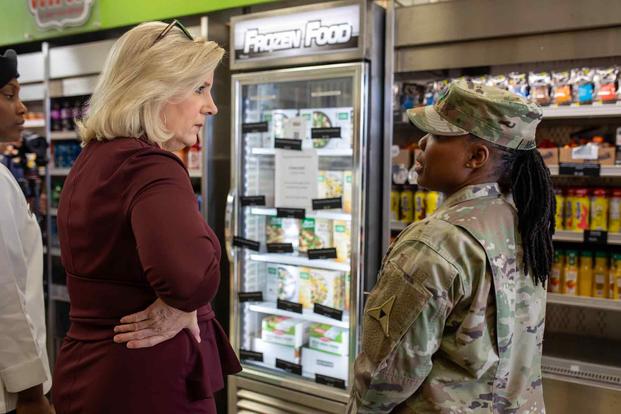The Army is spending at least $4 million to expand its so-called food kiosks on bases this year. But that new method of feeding soldiers does not have to follow the service's own nutrition rules and may quickly be out of date as Army officials eye allowing meal cards to be used at commissaries.
Kiosks are effectively small snack stands providing soldiers with sandwiches, candy, chips and soda -- offerings that hold little nutritional value and a selection akin to what's found at a typical gas station. By this time next year, most major installations will have at least one kiosk, with many high-profile bases having several. Fort Campbell, Kentucky, is set to have four of them.
The kiosks are broadly considered by key Army staff to be a piecemeal solution to an issue senior leaders have struggled to solve: Soldiers are not using dining facilities in numbers that warrant further investment. That's due to a variety of factors, according to troops, including poor walkability and public transportation on bases, dining facility food being low quality, and unreliable schedules keeping soldiers guessing when those facilities are open.
Read Next: Gordon and Aleksandra: Videos, Photos Show Relationship Between Detained Soldier and Russian Woman
But the kiosks so far appear to be far from a perfect solution.
"They brief well on paper, but the execution has not been great," Rob Evans, who runs the Hots&Cots app, a Yelp-style social media platform allowing troops to post reviews of dining facilities and barracks, told Military.com.
A main complaint soldiers have reported with kiosks is the poor quality of food and nutrition at many installations. In most cases, kiosks are stocked with food from the commissary. Due to a complicated web of bureaucracy, troops cannot use their meal cards directly at the on-base grocery stores.
"We need more options than Cheetos and Mountain Dew," one junior enlisted soldier told Military.com on the condition of anonymity because they were not authorized to talk to the press. "It's all snack food. It's fine once in a while. But you can't live off this stuff."
A review of the menus at several kiosks found that most items were high in sugar and low in protein and other critical nutrients, running afoul of the service's own standards. For example, male soldiers should get about 136 grams of protein each day, on average, though that guideline varies slightly based on body weight.
Getting the appropriate amount of protein can be difficult in kiosks -- at least without consuming roughly 100 grams of sugar along with it. Much of the food contains high levels of sugar. The American Heart Association recommends men have no more than 36 grams of added sugar per day.
In other cases, the food is usually pre-packaged and heavily processed. Soldiers have also reported issues with small portions, or being limited on what combinations of food they can select. Some installations have also struggled to keep shelves stocked.
The Army's regulation on nutrition, known as AR 40-25, is lagging behind the newly rolled out food stalls. The regulation has not been updated since 2017, a year before the first kiosks opened. Army staff have suggested that, because of this, kiosks can operate outside of the service's norms and policies.
"40-25 was developed for dining facilities; kiosks [are] an extension of dining facilities," William Duff, a logistics manager for the Army who works on its food policy, said at the military logistics conference last month. "Some of the [food in kiosks] meets 40-25, some don't."
Meanwhile, the service is also moving forward with plans to allow soldiers to use their meal cards at commissaries -- a move that could immediately neutralize the purpose of kiosks, which simply offer a snapshot of a commissary's options.
With that option on the table, it's unclear why the Army is investing heavily in kiosks, if they may quickly become obsolete as soldiers buy meals directly from commissaries. The service also plans to keep dining facilities open, but it's unclear whether there are plans for any investment in infrastructure improvements or higher-quality food.
"The Army Food Program's board of directors is currently developing a long-term plan for feeding soldiers and is exploring options such as allowing them to use their entitlements at all on-post eateries: commissaries, food courts, restaurants [and] MWR facilities," Matt Ahearn, a service spokesperson, told Military.com in a statement. "The Army is committed to providing soldiers with food options that are convenient, healthy and accessible."
Rollout of the kiosks falls under Army Materiel Command. Staff for AMC's acting commander, Lt. Gen. Christopher Mohan, and Command Sergeant Major Jimmy Sellers, declined to make either of them available for an interview.
AMC's commander was recently suspended by Army Secretary Christine Wormuth, marking the first time in a decade such a dramatic move was taken against a four-star general. Gen. Charles Hamilton was suspended following Military.com's reporting that he may have inappropriately subverted the Army's command selection process to bolster the career of a subordinate officer who was deemed unfit for leadership roles.
Related: The Army Is Going All-In on Food Kiosks as Base Dining Facilities Struggle














